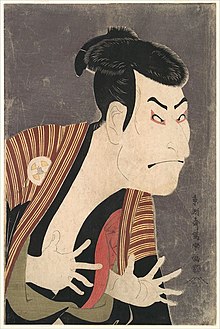Tōshūsai Sharaku

Tōshūsai Sharaku ( Japanese 東 洲 斎 写 楽 , at the time 寫 樂 ; * uncertain: mid-18th century) was the stage name of the Japanese Nō actor Saitō Jūrōbei , who later became one of the innovative and creative geniuses of Japanese woodblock printing ( ukiyo-e ). Little is known about his life.
The beginning of his graphic work is dated to 1787. Due to his world-famous portraits and caricatures of actors, which were created in just ten months from 1794 to 1795 and are often incorrectly listed as his only works, he is one of the greatest portrait artists of all time, along with Rembrandt and Velazquez .
biography
It is considered certain that "Tōshūsai Sharaku" was the stage name of the Nō actor Saitō Jūrōbei . This was initially in the service of the daimyo of Tokushima in Awa from the Hachisuka family. He later moved to Edo , today's Tokyo , where he lived in the Hatchobori district .
Artistic work
role models
Sharaku was influenced by woodcut masters such as Katsukawa Shunshō , Torii Kiyonaga and Kitagawa Utamaro , but does not seem to have had a permanent teacher. This would be supported by the fact that no part of his name was given to him by another artist, as was otherwise customary for masters with their students.
Early work
Julius Kurth dates the beginning of Sharaku's artistic work to 1787. A drawing by the actor Onoe Matsusuke (originally probably from a series) is known from this year, published by the small publisher Matsumura Yahe and already signed with “Sharaku”.
From 1788 Sharaku moved permanently to Tsutaya Jūzaburō , the most famous publisher in Edo at the time. With this he first published a series with depictions of Japanese gods of fortune , of which an Ebisu image has been preserved.
Between 1788 and the beginning of 1790 Sharaku created 17 series of so-called "narrow pictures" ( hoso-e ), which mostly consisted of three or five related motifs and showed well-known actors in their preferred stage roles and in private life in a naturalistic style.
In early 1790 a single sheet was created depicting the seven-year-old children's sumo wrestler Daidōyama Bungorō, who was very popular in Edo at the time. It is unusual that between 1788 and 1790, in addition to Sharaku, at least three other artists (Katsukawa Shunzan, Kitagawa Utamaro and Nagayoshi) made drawings for advertising purposes.
From the beginning of 1790 Sharaku signed his works with "Tōshūsai Sharaku".
Alternative theories
An alternative theory to Sharaku's biography is that Sharaku was not a real person, but a joint project of several artists. According to this, the name should be derived from “Sharakusai” (Japanese for “no sense”) to indicate that no real “Sharaku” existed. The argument put forward is that Sharaku's drawing style changed significantly over the course of the publications.
It seems unlikely, however, that at least one artist involved in such a “Sharaku project” would not have revealed his true identity or at least left further information.
Observations from today's perspective
The end of his career seems to be at least partly due to the fact that the radical nature of his work provoked the hostility of the artist scene in Edo. A contemporary manuscript says:
- "" Sharaku drew images of kabuki actors, but since he portrayed them too realistically, his prints did not correspond to accepted ideas and his career was short. "
It seems that the prints, which squeezed the last bit of truth out of his subjects by accurately depicting personal idiosyncrasies, left the customer feeling uncomfortable and made his prints difficult to sell. It seems plausible that he was unwilling to compromise and was therefore chased out of the world of art by his critics.
In fact, his art did not become popular among collectors in Japan until western artists and collectors discovered him in the late 19th century.
He is now considered one of the greatest of all wood block printing artists and the first 'modern' artist in Japan. The rare still existing originals fetch high sums at auctions.
literature
- Julius Kurth , Sharaku . R. Piper & Co., 1922, second, heavily edited edition
- Fritz Rumpf , Sharaku , Würfel-Verlag, 1932
- Otto Benesch , The late masters of the Japanese woodcut: Sharaku, Hokusai, Hiroshige , Lorenz-Verlag, 1938
- Franz Winzinger , Toshusai Sharaku - actor , Der silberne Quell Volume 24, Woldemar Klein Verlag, 1955
- Muneshige Narazaki , Sharaku: The Enigmatic Ukiyo-e Master , Kodansha, 1983, ISBN 0-87011-603-7 ; English
- Harold G. Henderson , Louis V. Ledoux , Sharaku's Japanese Theater Prints: An Illustrated Guide to his Complete Work . Dover Publications, 1984, ISBN 0-486-24704-X , English
Web links
- Literature by and about Tōshūsai Sharaku in the catalog of the German National Library
- Toshusai Sharaku Online (Engl.)
- http://www.ukiyo-e.de/Sharaku/sharaku.html
| personal data | |
|---|---|
| SURNAME | Tōshūsai Sharaku |
| ALTERNATIVE NAMES | 東 洲 斎 写 楽 (Japanese); Saitō, Jūrōbei (real name) |
| BRIEF DESCRIPTION | Japanese master of wood block printing |
| DATE OF BIRTH | around 1750 |
| DATE OF DEATH | around 1801 |

